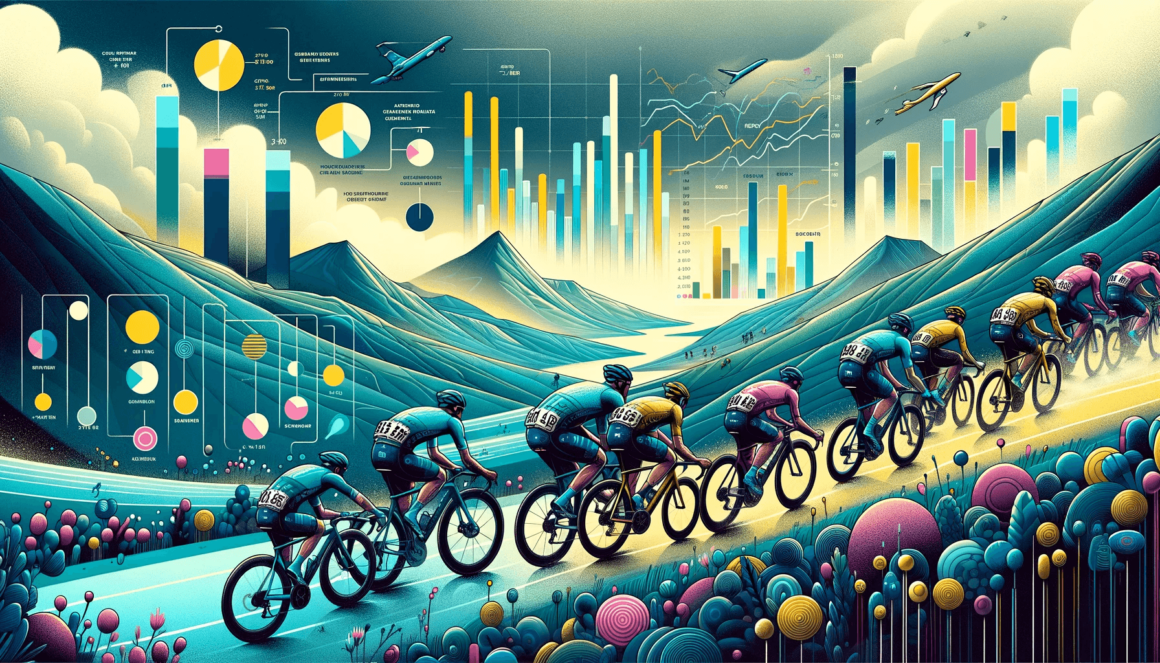2024 Tour de France Facts Every Fan Should Know
Tour de France is the pinnacle of the cycling world. As the name suggests, it is a tour around France, and it’s one of the oldest and most famous sporting events in the world. We’ve gathered essential Tour de France facts that every fan or newcomer to the sport should know.
Keep reading below to find out the most interesting facts about “Le Tour,” as the French call it, and gain some sporting knowledge you can brag about.
Highlights of the Article
- Facts about the Tour de France show that the first-ever race was in 1903.
- The Tour de France record for the longest race distance is 5,745 km.
- Mountain stages were introduced in 1910, according to fun facts about the race.
- The yellow jersey was introduced in 1919.
- Tour de France numbers show that the smallest winning margin is eight seconds.
- The fewest number of cyclists to complete the Tour de France is 10.
- Alcohol was used as a stimulant until the 1960s.
- Tour de France statistics show that there are 21 stages throughout the race.
- One of the darkest race facts is that it’s filled with doping scandals.
- Riders consume about 126,000 calories during the race.
General Tour de France Stats

If you’re a casual fan or one of the 50% of U.S. adults that bet on sporting events, then you need to know the following statistics to have a better knowledge of the event.
1. Tour de France facts show that the first-ever race was in 1903.
(History)
The race was created by Henri Desgrange, the editor of L’Auto newspaper, and Geo Lefevre, the paper’s journalist. It was a stunt to boost sales. Sixty cyclists covered the 1,500-mile race, united by the challenge and the 20,000 Francs prize money.
2. According to Tour de France statistics, there are 21 stages throughout the race.
(BBC)(Britannica)
Each year, the stages’ location and length change, but every year, there are different types — flat, time trial, and mountain. The total distance ridden is about 3,600 kilometers, or about 2,200 miles.
If you want to learn more, we’ve created a detailed breakdown and gathered other Tour de France facts about the 2021 race.
3. Facts about the Tour de France show that there are 22 teams in the race.
(BBC)
Each year, there are 22 teams with up to nine riders each, making the Tour de France number of riders up to 198.
Each team has a leader, and the rest of the team works hard to help him win. They ride in front of him to protect him from the wind, block other teams, pass him food and water, and even lend him their bike if his breaks down.
4. An unbelievable Tour de France fact is that riders consume about 126,000 calories during the race.
(Cycling Weekly)
To be able to complete the race, riders need to have plenty of energy. On average, riders consume about 5,000 calories per day during the flat stages, and in the mountains — around 7,000 calories. They also consume about 10L (2.5 gallons) of water per day.
5. The Grand Depart starts at different locations, but the finish is always in Paris, Tour de France facts show.
(France 24)(Le Tour)
The start of the race is called the Grand Depart and starts in different locations, often outside France.
It has begun outside France 23 times so far, with the Netherlands being the most common starting point — six times. In 2022, the race will start in Denmark, and in 2023, in Spain.
The final, however, has always been in Paris. In 2021, it will be the 47th time it ends at the Champs-Elysees.
6. Pre-COVID, there were an estimated 12 million spectators of the Tour de France standing along the road.
(DW)(Cyclist)
While the exact number is unknown, it has been estimated that there are usually around 12 million people watching the race.
They stand along the road or wherever they can find a place to watch. There are no tickets, and the event is free to watch if you can find a spot.
The Tour claims that a total of 3.5 billion viewers across 190 countries follow the event. That’s a combination of all the stages. In perspective, the Super Bowl was the most-watched event in the U.S. in 2020, with 100 million viewers.
7. One of the darkest Tour de France facts is that it’s filled with doping scandals.
(Britannica)
Unfortunately, you can’t look up Tour de France and not see anything about doping. Doping implies using performance-enhancing substances, aka steroids, to gain an advantage. There have been multiple high-profile instances of doping.
The most famous one involves Lance Armstrong, the seven-time winner. As it happens, he was stripped of his titles and results in 2012. Two other Tour de France winners, 2006 winner Floyd Landis and 2010 winner Alberto Contador were also stripped of their titles.
In 1998, the Festina team was banned due to drug-use allegations.
Historical Tour de France Stats
You cannot be an expert on a subject if you don’t know its history. This is why we’ve gathered some facts about the history of the Tour that you need to know about.
8. The Tour de France record for the longest race distance is 5,745 km.
(Britannica)
5,000+ km races were standard in the 1910s and ’20s. But the record was set in 1926, for the 20th anniversary of the race, with 5,745 km (3,570 miles). Lucien Buysse from Belgium won it.
9. Mountain stages were introduced in 1910, according to the Tour de France fun facts.
(Cycling Today)
In 1910, L’Auto journalist Alphonse Steines wanted to make the race more monumental and include the mountains. Desgrange was reluctant but sent Steines to check if it seemed possible.
Steines got stuck in the snow and got hypothermia, but he still sent a telegram saying everything looks great. The rest, as we say, is history.
10. Another interesting Tour de France fact is that the yellow jersey was introduced in 1919.
(The Smithsonian Mag)
After the WWI hiatus, le Tour returned. Two-thirds through the race, Desgrange decided that a clear indicator of the race leader is needed. The choice of yellow jersey came from the color that the L’Auto newspaper was printed in — yellow.
11. A fun piece of Tour de France trivia is that alcohol was used as a stimulant until the 1960s.
(Bicycling.com)
In the early years of the race, alcohol was considered a stimulant. Riders often stopped in bars and had a beer or even wine.
In 1935, the whole peloton stopped for a drink, except Julien Moineau, who won. Also, in the 1920s, cigarettes were smoked to “open up the lungs.”
12. Tour de France numbers show that the smallest winning margin is eight seconds.
(Cycling Weekly)
In 1989, Greg LeMond won the Tour by 8 seconds. He entered the last stage trailing two-time winner Laurent Fignon by 50 seconds.
Many point out Fignon’s ponytail as the reason for the loss. In comparison, the largest margin, set in 1903, was 2 hours, 49 minutes, and 45 seconds.
13. On Tour de France, the fastest time was set in 2005.
(Le Tour)(Bike Race Info)
As the race is different every year, in terms of distance, the fastest time is calculated based on the winner’s average speed. The fastest average speed was achieved in 2005 with 41.654 km/hr (25.9 mph) by Ivan Basso.
We should point out that Basso finished second that year behind Lance Armstrong, who averaged 41.7 km/hr, but his results were annulled.
Tour de France Statistics About Cyclists
Now that you’ve learned about the race and its history, keep reading to learn about the cyclists and some of the most crucial statistics.
14. Four Tour de France winners share the record for most wins, with five each.
(Britannica)
Four riders have their names in history with five wins: Jacques Anquetil (1957, 1961–64), Eddy Merckx (1969–72, 1974), Bernard Hinault (1978–79, 1981–82, 1985), and Miguel Indurain (1991–95).
As mentioned, Lance Armstrong’s seven titles were stripped away.
15. Tour de France rider stats show that the youngest winner was 19 years and 355 days old.
(Guinness World Records)(Guinness World Records)
Henri Cornet was not even 20 years old when he won the Tour in 1904. Interestingly, his win is that he finished fifth, but the first four riders were disqualified.
In comparison, the oldest winner is Firmin Lambot, who was 36 years and four months old in 1922.
16. One of the Tour de France fun facts is that there are multiple colored jerseys worn.
(BBC)
There are four jerseys worn:
- Green jersey — goes to the points leader
- Polka dot jersey — goes to the winner of the mountain stages
- White jersey — given to the best driver under the age of 25
- Yellow jersey — the most important one, given to the leader of the race.
17. According to Tour de France standings, Eddy Merckx leads in most stages won and most days wearing the yellow jersey.
(Statista)(Statista)
In addition to sharing the No.1 spot for most overall wins, Eddy Merckx also holds the records for most stages won (34) and most days wearing the yellow jersey — 111.
18. The fewest number of cyclists to complete the Tour de France is ten.
(Bike Race Info)(Le Tour)
In 1919, the same race during which the yellow jersey was introduced, only ten participants completed the Tour. That was mainly due to bad road conditions resulting from WWI.
The winner was Firmin Lambot, who would also win the 1922 race and become the oldest winner.
19. Le Tour de France facts show that Sylvain Chavanel has started 18 races, the most.
(Cycling Weekly)
Sylvain Chavanel from France started all the races 2001–18. He finished all except the 2007 and 2012 ones. That ties him for the No.1 spot with Joop Zoetemelk from the Netherlands.
We should point out that George Hincapie technically finished even more races, but he was stripped of his results due to doping.
20. The resting heart rate of Tour de France riders is around 40 bpm.
(Whoop)
While an average person’s resting heart rate (RHR) is between 60 and 100, the riders’ rate is around 42. RHR is a measurement of average heartbeats while your body is at rest. The lower that number is, the better.
Riders also record a heart rate variability of about 139 ms, compared to the average person’s 64 ms.
Heart rate variability is the measurement of how well your body can take physical exercise and strenuous activity. The rate improves from exercise, diet, rest, and other factors.
Conclusion
“Le Tour” is the most prestigious cycling race and one of the most-watched and anticipated events in the world. There have been many changes and events that have shaped the race that is today.
This is why we are sure our Tour de France facts will help you gain valuable knowledge about an event you follow or can use them to bet on the race.
FAQ
How many Tour de France winners were stripped?
Four riders have been stripped. Most notably, Lance Armstrong’s seven titles (1999–2005) were all stripped.
The 2006 winner Floyd Landis, 2010 winner Alberto Contador, and 1904 winner Also Garin. 1996 winner Bjarne Riis admitted to taking steroids but wasn’t stripped.
Who is the greatest Tour de France rider?
If he hadn’t been caught, most would point at Lance Armstrong, but as we know, he didn’t win his titles fairly.
Looking at stats — such as most wins, most stages won, and most days wearing the yellow shirt — we can arguably say it’s Eddy Merckx. Still, many more can arguably claim that title.
Do Tour de France riders lose weight?
The goal throughout the race is to maintain the weight. Although some weight loss is possible, it’s not significant.
While riders go through a very grueling race and burn many calories, they consume an outrageous amount of food and liquids to achieve calorie excess.
Is the Tour de France the hardest sporting event?
While the answer to the question is subjective, we can argue that Le Tour is among the most challenging events ever. Riding over 2,000 miles in the middle of summer and going uphill will test even the most skilled athlete.
What is the prize money for the Tour de France?
The prize pool of the Tour is €2.3 million ($2.8 million), and the winner gets €500,000 ($608,500). It is common for the winner to share the winnings with the rest of his team as they work hard to help.
How many Tour de Frances have there been?
The tour has been held every year since 1903 except for WWI and WWII. There were no events between 1915 and 1918 (WWI) or 1940 and 1946 (WWII). The race of 2020 was the 107th edition of the event.
 BC.Game
BC.Game  7Bit
7Bit  Ducky Luck
Ducky Luck  Red Dog
Red Dog